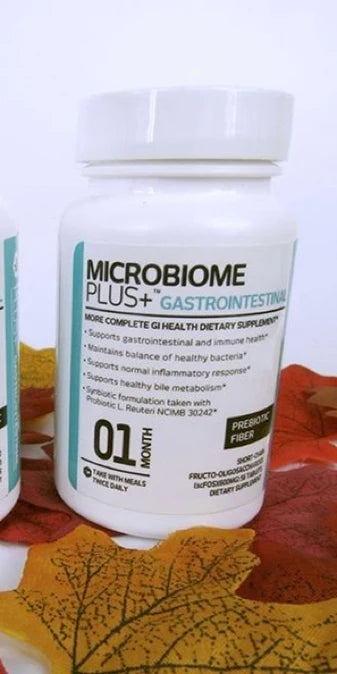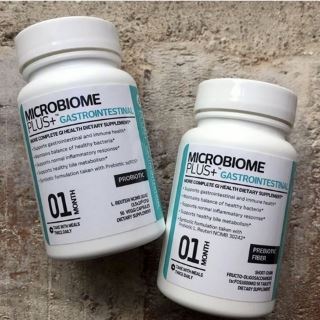Doing all the right things but still getting UTIs or yeast infections? If you're in your 40s or 50s, shifting hormones, stress, and gut imbalances could be quietly throwing off your vaginal and urinary microbiome. This in-depth guide covers the specific probiotic strains shown to help restore balance and reduce the recurrence of infections, along with expert tips on how and when to use them safely and effectively.
Disclaimer: This post is for informational purposes only. Please discuss your health concerns with your care provider and consult them before taking any supplements to avoid disease and drug interactions.
Key Points
- UTIs and yeast infections are often caused by microbiome imbalances, especially in the urinary and vaginal tracts, not just by poor hygiene or sexual activity.1
- Hormone shifts, antibiotics, stress, and poor diet can all deplete protective bacteria like Lactobacilli, especially during perimenopause and menopause.2,3
- Lactobacillus rhamnosus GR-1 and Lactobacillus reuteri RC-14 are the best-studied probiotics for preventing both UTIs and vaginal yeast infections.4,5
- Vaginal probiotics work better than oral ones, but combining both may offer the strongest protection against recurring infections.6,7
- Probiotics are more effective for prevention than for managing active infections, and results take consistency (especially if you’ve had recurrent infections).6
Are You a Visual Learner? Check Out Our Infographic

Healthy Urinary Tract vs Urinary Tract Infection (UTI)
The urinary tract was long considered to be sterile, but we now know that it’s home to an array of good bacteria that make up the urinary microbiome or urobiome.8
A healthy urinary tract in women is particularly abundant in Lactobacillus bacteria, many of which are also used as probiotics.1
Our 40 billion probiotic blend with prebiotics contains 1 Bifidobacterium and 3 Lactobacillus probiotic strains, including Lactobacillus acidophilus (La-14) which is known to support vaginal health.9
Lactobacillus bacteria work to maintain the health of the urinary and vaginal tract in women by decreasing the pH and helping to fight off or prevent the growth of “bad” bacteria.1
An imbalance or dysbiosis of the urinary microbiome is linked to urinary tract infections (UTIs) and other health complications like interstitial cystitis, urinary incontinence, and bladder pain syndrome.1
Why did I get a UTI out of nowhere?
Getting a UTI all of a sudden and without a clear cause is frustrating. And although you may feel like it happened out of the blue, many lifestyle and diet factors might’ve silently contributed.
If you’re dealing with a UTI right now or have had recurrent UTIs in the past, this is a chance to take a closer look at your lifestyle, diet, and gut health and spot the possible triggers.
Risk Factors
Overall, women are much more prone to UTIs than men, although men have a similar urinary microbiome.1
One reason for this is purely anatomical. UTIs can happen when bacteria enter the urinary tract from the urethra and travel up to the bladder, where they multiply. Women have a shorter urethra than men, and it’s closer to the anus, making it easier for bacteria to enter. The most common culprit of UTIs in women is E. coli, a bacterium normally found in the gastrointestinal tract.1
In younger women, sexual intercourse, using spermicides, and prior UTIs also increase the risk of another infection. In post-menopausal women, the main risk factors are: prior UTI, incontinence, diabetes, and sexual intercourse.10
Many health professionals recommend urinating before and after sex to help flush out the bacteria. Studies suggest this practice may indeed help with UTI prevention.11
Hormonal influences
If you’re peri- or post-menopausal, a drop in estrogen levels can decrease protective bacteria like Lactobacilli in your urinary tract, contributing to a higher risk of UTIs.2,3
Read more about probiotics for menopause specifically in this post.
Microbiome Imbalances & Lifestyle
Bacteria like E. coli can also be a part of a healthy urobiome. E. coli seems to cause more trouble when it’s paired with other pathogenic bacteria and an imbalance in the urobiome.1
This means that some UTIs are not caused by bacteria simply entering the urinary tract, but by the existing bacteria getting out of hand.1 That’s where probiotic supplementation comes in, and we’ll cover the best-researched strains in the next section.
According to some scientists, the culprit for UTIs may lie in vaginal microbiome disruption. When beneficial Lactobacilli are depleted, harmful bacteria can colonize the vaginal flora and travel to the urinary tract. This may explain why many studies using vaginal probiotics showed benefits for UTIs.6
Lifestyle factors also play in. High stress, poor diet, and drinking too much alcohol can make you more susceptible to UTIs by weakening your immune system and disrupting your gut microbiome.12,13
The Bottom Line
UTIs might seem to appear out of nowhere, but factors like stress, diet, hormones, and microbiome imbalances often play a hidden role. Women are especially prone due to anatomy, life stage, and lifestyle habits, making it important to look at the bigger picture—especially gut, vaginal, and urinary health.
What Probiotics are Good for UTIs and Yeast Infections?
Summary
UTIs and vaginal yeast infections often go hand in hand, and both are linked with urinary and vaginal microbiome imbalances.1,14
Both oral and vaginal probiotics may be used to help prevent or recover from a UTI and yeast infection.
Here are the best researched probiotic strains for preventing UTIs:4,15
- Lactobacillus rhamnosus GR-1
- Lactobacillus reuteri RC-14
- Lactobacillus casei shirota
- Lactobacillus crispatus CTV-05
- Lactobacillus acidophilus (La-14) with D-mannose
The first two strains were most effective in studies, followed by the latter three.
Meanwhile, Lactobacillus rhamnosus GG, which is otherwise great for gut health, didn’t help with UTI recurrence.4
For vaginal yeast infections, the following probiotics were found to help prevent recurrence:16
- Lactobacillus rhamnosus GR-1
- Lactobacillus reuteri RC-14
- Lactobacillus gasseri LN40
- Lactobacillus fermentum LN99
- Lactobacillus casei subsp. rhamnosus LN113
Again, the first two strains were found to be most effective. These are the same strains that work best for UTI prevention as well!
Now let’s take a closer look at the research and what experts say.
The Bottom Line
UTIs and yeast infections often occur together and are both linked to microbiome imbalances. Oral or vaginal probiotics—especially Lactobacillus rhamnosus GR-1 and Lactobacillus reuteri RC-14—may help prevent both and support recovery.
Lactobacillus Probiotics: Expert Tips & Research Breakdown
Based on the existing research, there’s solid evidence to support the use of both oral and vaginal Lactobacillus probiotics in women with UTIs.6 Although the clinical evidence is still limited, experts tend to agree that several Lactobacillus strains are a safe and promising option.
Lactobacillus probiotic strains work by helping to replenish the vaginal and urinary microbiomes in women battling chronic UTIs and yeast infections. Lactobacilli make the vaginal and urinary microbiome less inflammatory and more immune-active, which helps prevent the infection from coming back.6
“I recommend probiotics as a self-care option that patients could try at home and buy over the counter, for recurrent UTIs or yeast infections. It’s a well-tolerated and ‘safe’ option for most women to try,” explains Dr Nicholas Dragolea, MD, and a London-based GP. “I recommend Lactobacillus strains specifically as some studies have shown that both oral and vaginal lactobacilli can decrease UTI recurrence and are generally well tolerated,” he adds.
The research Dr. Dragolea is referring to covers several clinical studies and scientific reviews.
The most cited clinical study reported success with an oral Lactobacillus probiotic, showing that the lactobacilli taken by mouth can reach the vaginal microbiome. In the study, 10 women with a history of recurrent yeast vaginitis, bacterial vaginosis (BV), and UTIs, took Lactobacillus rhamnosus GR-1 and Lactobacillus reuteri (previously called fermentum) RC-14 in skim milk twice daily for 14 days. In six cases, bacterial vaginosis was resolved within 1 week.17
In this study, women also reported UTI symptom relief, and one woman cleared an enterococcal bladder and vaginal infection within a week of supplementation. Although this study is encouraging, it also unfortunately had a tiny sample. Larger studies would need to confirm its success.17
The Bottom Line
Lactobacillus probiotics (both oral and vaginal) show promise for preventing recurring UTIs and yeast infections by restoring healthy vaginal and urinary microbiomes. While more research is needed, early studies and experts support their use as a safe, over-the-counter option.
Probiotics for UTI Prevention
“In general, I would recommend probiotics for almost everyone, not just in preventing UTIs, but they serve as a good adjunct to lifestyle modification in preventing UTI and yeast infections,” says Dr. Austin Shuxiao, board-certified Internal Medicine Doctor in the United States based in NYC.
“Probiotics should not be used to treat UTI or yeast infections, and in patients with active UTI or yeast infections, I use medical treatment like antibiotics and antifungals,” Dr. Shuxiao highlights.
“Probiotics should only be used as a preventative strategy against UTIs, but the likelihood of seeing meaningful results in reducing UTI rates may be small on an individual level. In any case, probiotics have excellent health benefits in many other systems of the body, and have a very low side effect profile, so there is no harm,” he adds.
Dr. Shuxiao recommends the four main strains that have been researched for UTI prevention, breaking down their benefits.
“Lactobacillus rhamnosus GR-1 and Lactobacillus reuteri RC-14 are the most studied and effective strains for UTI prevention. They are excellent at restoring healthy vaginal flora,” he explains.
“Lactobacillus crispatus CTV-01 is the lactobacillus that makes up the majority of the bacterial flora in healthy women and protects well against UTIs. Lactobacillus casei shirota is the probiotic found in Yakult and is mildly effective at preventing UTI,” Dr. Shuxiao concludes.
He adds that Bifidobacterium strains are included in probiotics but are not typically a party of vaginal or bladder flora and are not as effective as lactobacillus probiotics.
The Bottom Line
Probiotics can help prevent UTIs and yeast infections but shouldn't be used to treat active infections. Lactobacillus strains like L. rhamnosus GR-1, L. reuteri RC-14, and L. crispatus CTV-01 are well-researched for UTI prevention and for supporting a healthy vaginal flora.
Key Question: Can Your Lactobacillus Probiotic Colonize the Vaginal Microbiome?
Although oral probiotics tend to be more popular, vaginal probiotics seem to be more effective at helping prevent UTIs from coming back. The reason for this is that a healthy vaginal microbiome can protect the urinary tract, and vaginal probiotics are more effective at restoring vaginal microbiome balance.6
Even if you decide to use a vaginal formulation, it’s important to choose one with strains that have been proven to colonize the vaginal tissue.
One large systematic review examined if Lactobacillus probiotics can help prevent recurrent UTIs in a sample of 294 patients from five studies. They found no effect of probiotics on preventing UTIs. But when they narrowed the dataset down to 127 patients in two studies that used only Lactobacillus strains known to colonize the vaginal tissue, probiotics did have a positive effect on preventing UTIs.6
In the first study they mention, Lactobacillus rhamnosus GR-1 and Lactobacillus reuteri RC-14 used vaginally helped reduce recurring UTIs from 47% to 21% during a 6-month period in 41 premenopausal women.18
The second study gave Lactobacillus crispatus CTV-05 vaginally to 100 premenopausal women 7-10 days after antibiotic treatment and found:19
- 15% recurrent UTIs in women given vaginal probiotics
- 27% recurrent UTIs in the placebo group
- Higher levels of probiotic colonisation in the probiotic group
Of these strains, Lactobacillus rhamnosus GR-1 and Lactobacillus reuteri RC-14 can also colonize the vaginal microbiome after oral use for at least 1-2 weeks.6,17
The authors highlight that the reason why some other analyses failed to find a beneficial effect of probiotics is because they were including studies using strains that can’t colonize the vaginal microbiome!6
That means that some strains are simply not adequate for UTIs! They might be good probiotics for other health issues, like Lactobacillus rhamnosus GG is for gut health, but they’re not probiotics for urinary and vaginal imbalances.4
The Bottom Line
Probiotic strains like Lactobacillus rhamnosus GR-1, Lactobacillus reuteri RC-14, and Lactobacillus crispatus CTV-05 may help prevent recurrent UTIs by rebalancing the vaginal microbiome. They seem to be more effective when used vaginally than orally.
Using Both Vaginal and Oral Probiotics for UTI Prevention
Some studies suggest that using both vaginal and oral probiotics may be a smart option.7
In one clinical trial, 174 premenopausal women with a history of recurrent UTIs received either a placebo, an oral lactic acid and bifidobacteria probiotic, vaginal lactobacilli, or both vaginal lactobacilli and an oral lactic acid and bifidobacteria probiotic.7
After 4 months of following the regimen, they found that:7
- 70% of women in the placebo group had another UTI
- 61% of the women taking only the oral probiotic had a UTI
- 41% of the women taking only the vaginal probiotic had a UTI
- 32% of the women taking both the oral and vaginal probiotic had a UTI
It’s clear to see that vaginal probiotics were more effective, but women on the vaginal + oral probiotic combo experienced the most significant benefits.7
Also, women taking vaginal probiotics with or without oral probiotics had a longer UTI-free period (over 120 days, compared to 71 days in the oral probiotic group).7
It’s possible that the Lactobacillus probiotic strains this study was using in the oral protocol can’t colonize the vaginal microbiome, which might explain why it didn’t help much.
The vaginal probiotic contained Lactobacillus plantarum FV9, Lactobacillus salivarius FV2 and Lactobacillus brevis CD2.7
The Bottom Line
Research suggests that vaginal probiotics may work better to prevent recurrent UTIs, especially when combined with oral probiotics. Oral probiotics alone weren’t as effective.
Multi-strain Oral Lactobacillus and Bifidobacterium Probiotics
Some multi-strain products also show promise for helping prevent recurrent UTIs, even when used orally.22
One study used an oral multi-strain probiotic with 6 Lactobacillus strains, Bifidobacterium bifidum UBBB-55, and prebiotic fructo-oligosaccharide in 51 women as an add-on to antibiotic treatment. They found:22
- Reduced UTI recurrence in the probiotic group
- 75% of participants in the probiotic group remained recurrence-free
- Only 33% of those in the placebo group remained recurrence-free
The authors conclude that specific multi-strain Lactobacillus and Bifidobacterium probiotics can be a valuable add-on to antibiotic treatment in women with recurrent UTIs.22
This study is also interesting because probiotics were started along with antibiotic therapy and continued for another 23 weeks. While on antibiotics, patients were advised to best take the probiotic at least 2 hours after the antibiotic.22
The Bottom Line
Multi-strain Lactobacillus and Bifidobacterium oral probiotics may also help reduce UTI recurrences, but more research is needed.
Probiotics for UTIs in Children
UTIs in children are also relatively common and stubborn, often leading parents into a vicious cycle of giving antibiotics to their children to get rid of the infection but having to deal with gut and immune issues from long-term antibiotic use after.
While antibiotics are often needed to resolve an active infection, they can trigger imbalances in gut microbiota in children called pediatric gut dysbiosis.20
Since the human microbiome is shaped in childhood, frequent antibiotic use may cause lasting microbiome changes that may predispose children to obesity, allergies, eczema, and other health issues in adulthood.20
For this reason, many parents seek holistic options to help balance their child’s immune system and microbiome in the long run. One study suggests that Lactobacillus probiotics may even help prevent recurrent UTIs in children.21
In the study, probiotics containing Lactobacillus rhamnosus PL1 and Lactobacillus plantarum PM1 or a placebo were given to 54 children aged 3-18 years with recurrent UTIs for 90 days. During the study, children taking the probiotic had a 50% decrease in UTIs compared to the placebo. The authors conclude that probiotics can be a safe, natural strategy for preventing recurrent UTIs in children who don’t need antibiotics at the moment.21
The Bottom Line
UTIs are common in children, but frequent antibiotic use can disrupt their developing gut microbiome and increase long-term health risks. Probiotics like Lactobacillus rhamnosus and plantarum may help prevent recurrent UTIs and support gut and immune health in kids.
Other
Lactobacillus + D-mannose
In one study, a combination of Lactobacillus acidophilus (La-14), D-mannose, and salicin from dry willow extract helped reduce recurrent UTI symptoms due to E. coli infection in 85 participants.15
Over the first 5 days, participants received high-dose D-mannose and salicin. This was the “attack phase,” aimed at fighting off the bacteria. Participants were then given D-mannose with Lactobacillus acidophilus (La-14) for 7 days as maintenance. The maintenance treatment was repeated every 15 days for the next two months. Patients on this regimen experienced overall UTI symptom relief, including reduced incontinence and urgency.15
Although encouraging, larger studies would need to confirm the benefits of this regimen.
Fermented Milk Products
Some studies suggest that women who consume fresh berry or fruit juices and fermented milk products containing probiotic bacteria have a lower risk for UTI recurrence.23
Fermented & Plant-Based Foods
One review suggests that fermented foods such as yogurt, kefir, and kombucha may help support the gut and urogenital microbiota, enhancing resistance to harmful bacteria.24
Plant-based foods, including cranberry, garlic, bearberry, juniper, and nettle are also mentioned as a beneficial add-on. These foods contain active compounds that may help reduce inflammation, fight pathogens, and flush out bacteria due their diuretic properties. However, the evidence is weak and more anecdotal.24
It’s also important to remember that although fermented foods are generally healthy, only a few may contain enough beneficial bacteria to be classified as probiotics.
Nonetheless, these foods and herbs may be part of an integrative approach to UTI prevention.
“I also like to offer my clients the option to select taking probiotic supplements, nitric oxide probiotics, herbal teas or medicinal herbal tinctures because not everyone like to ingest capsules. Clients who have food allergies or are lactose intolerant have a variety of effective options to restore balance when dealing with a UTI or yeast infection,” says Shanna Bynes Bradford LME, MA, CR, MUA, Master Aromatherapist Chemist.
She adds that it’s important to avoid synthetic ingredients and additives and make sure the probiotic you’re taking is safe and right for you, as a higher colony forming units (CFU) count isn’t always better.
Probiotic yeasts
Some probiotic yeasts may be helpful for vaginal yeast infections, although they’re unlikely to affect your urinary tract. In one study, Saccharomyces cerevisiae var. boulardii was active against various Candida species that are known to cause vaginal yeast infections in women.25
More research is needed to determine how effective probiotic yeast are for vaginal yeast infections.
The Bottom Line
A combination of D-mannose, Lactobacillus acidophilus, and willow extract may help reduce UTI symptoms, but more research is needed. Fermented foods, certain herbs, and probiotic yeasts may also support urinary and vaginal health as part of a broader, personalized approach.
A Word of Caution
In several analyses of the published studies, probiotics didn’t reduce the recurrence of UTIs compared to the placebo.26,27
The authors point out that this doesn’t rule out a benefit since the existing data are limited to small studies that used different strains, dosages, and formulations.
Yet, the overall evidence on whether probiotics can help prevent UTIs or reduce the symptoms is mixed. Although several studies had positive results, more high-quality research is needed to confirm the benefits and determine which probiotic strains, dosages, and ways of applying them might work best for UTIs.
Should I take probiotics while I have a UTI?
If you have an active UTI and are taking antibiotics, it’s best to first consult your healthcare provider before taking probiotics.
Although some studies have used probiotics as an add-on to antibiotic treatment, interactions are possible. If taken closely together, antibiotics can kill probiotic bacteria. This makes the probiotic ineffective. In general, it’s advised to wait at least 2 hours after taking antibiotics before taking probiotics.
Some practitioners recommend waiting until your antibiotic or antifungal therapy is fully over before starting probiotics.
Overall, probiotics seem to work best as prevention. That means taking them before you get another UTI if you’re prone to them.
“If you believe you are having an active UTI or yeast infection, do not use probiotics to treat it. Go to a doctor to receive an antibiotic or antifungal. However, if you are someone who is prone to frequent UTIs, yeast infections, or are generally healthy but want to boost your health and immunity, then taking a supplemental probiotic for preventing UTI and yeast infections is a good idea,” explains Dr. Austin Shuxiao, MD.
Whatever you decide, remember that probiotics are a long-term strategy. It takes time and consistency to get results, so don’t give up if you’re just starting!
This post references ✔ 27 trusted sources.
References:
1. Kustrimovic N, Bilato G, Mortara L, Baci D. The Urinary Microbiome in Health and Disease: Relevance for Bladder Cancer. Int J Mol Sci. 2024;25(3):1732. Published 2024 Jan 31. doi:10.3390/ijms25031732
2. Vaughan MH, Mao J, Karstens LA, et al. The Urinary Microbiome in Postmenopausal Women with Recurrent Urinary Tract Infections. J Urol. 2021;206(5):1222-1231. doi:10.1097/JU.0000000000001940
3. Park MG, Cho S, Oh MM. Menopausal Changes in the Microbiome-A Review Focused on the Genitourinary Microbiome. Diagnostics (Basel). 2023;13(6):1193. Published 2023 Mar 21. doi:10.3390/diagnostics13061193
4. Falagas ME, Betsi GI, Tokas T, Athanasiou S. Probiotics for prevention of recurrent urinary tract infections in women: a review of the evidence from microbiological and clinical studies. Drugs. 2006;66(9):1253-1261. doi:10.2165/00003495-200666090-00007
5. Zahedifard T, Khadivzadeh T, Rakhshkhorshid M. The Role of Probiotics in the Treatment of Vulvovaginal Candidiasis: A Systematic Review and Meta-Analysis. Ethiop J Health Sci. 2023;33(5):881-890. doi:10.4314/ejhs.v33i5.18
6. Grin PM, Kowalewska PM, Alhazzan W, Fox-Robichaud AE. Lactobacillus for preventing recurrent urinary tract infections in women: meta-analysis. Can J Urol. 2013;20(1):6607-6614.
7. Gupta V, Mastromarino P, Garg R. Effectiveness of prophylactic oral and/or vaginal probiotic supplementation in the prevention of recurrent urinary tract infections: A randomized, double-blind, placebo-controlled trial. Clinical Infectious Diseases: An Official Publication of the Infectious Diseases Society of America. 2023;78(5):ciad766. doi:https://doi.org/10.1093/cid/ciad766
8. Aragón IM, Herrera-Imbroda B, Queipo-Ortuño MI, et al. The Urinary Tract Microbiome in Health and Disease. Eur Urol Focus. 2018;4(1):128-138. doi:10.1016/j.euf.2016.11.001
9. Superti F, De Seta F. Warding Off Recurrent Yeast and Bacterial Vaginal Infections: Lactoferrin and Lactobacilli. Microorganisms. 2020;8(1):130. Published 2020 Jan 17. doi:10.3390/microorganisms8010130
10. Moore EE, Hawes SE, Scholes D, Boyko EJ, Hughes JP, Fihn SD. Sexual intercourse and risk of symptomatic urinary tract infection in post-menopausal women. J Gen Intern Med. 2008;23(5):595-599. doi:10.1007/s11606-008-0535-y
11. Foxman B, Chi JW. Health behavior and urinary tract infection in college-aged women. J Clin Epidemiol. 1990;43(4):329-337. doi:10.1016/0895-4356(90)90119-a
12. Chess-Williams R, McDermott C, Sellers DJ, West EG, Mills KA. Chronic psychological stress and lower urinary tract symptoms. Low Urin Tract Symptoms. 2021;13(4):414-424. doi:10.1111/luts.12395
13. Du Y, Sui X, Bai Y, et al. Dietary influences on urinary tract infections: unraveling the gut microbiota connection. Food Funct. 2024;15(19):10099-10109. Published 2024 Sep 30. doi:10.1039/d4fo03271c
14. Dubé-Zinatelli E, Cappelletti L, Ismail N. Vaginal Microbiome: Environmental, Biological, and Racial Influences on Gynecological Health Across the Lifespan. Am J Reprod Immunol. 2024;92(6):e70026. doi:10.1111/aji.70026
15. Del Popolo G, Nelli F. Recurrent bacterial symptomatic cystitis: A pilot study on a new natural option for treatment. Arch Ital Urol Androl. 2018;90(2):101-103. Published 2018 Jun 30. doi:10.4081/aiua.2018.2.101
16. Zahedifard T, Khadivzadeh T, Rakhshkhorshid M. The Role of Probiotics in the Treatment of Vulvovaginal Candidiasis: A Systematic Review and Meta-Analysis. Ethiop J Health Sci. 2023;33(5):881-890. doi:10.4314/ejhs.v33i5.18
17. Reid G, Bruce AW, Fraser N, Heinemann C, Owen J, Henning B. Oral probiotics can resolve urogenital infections. FEMS Immunol Med Microbiol. 2001;30(1):49-52. doi:10.1111/j.1574-695X.2001.tb01549.x
18. Reid G, Bruce AW, Taylor M. Influence of three-day antimicrobial therapy and lactobacillus vaginal suppositories on recurrence of urinary tract infections. Clin Ther. 1992;14(1):11-16.
19. Stapleton AE, Au-Yeung M, Hooton TM, et al. Randomized, placebo-controlled phase 2 trial of a Lactobacillus crispatus probiotic given intravaginally for prevention of recurrent urinary tract infection. Clin Infect Dis. 2011;52(10):1212-1217. doi:10.1093/cid/cir183
20. Vangay P, Ward T, Gerber JS, Knights D. Antibiotics, pediatric dysbiosis, and disease. Cell Host Microbe. 2015;17(5):553-564. doi:10.1016/j.chom.2015.04.006
21. Daniel M, Szymanik-Grzelak H, Sierdziński J, Pańczyk-Tomaszewska M. Lactobacillus rhamnosus PL1 and Lactobacillus plantarum PM1 versus Placebo as Prophylaxis for Recurrence of Urinary Tract Infections in Children. Microorganisms. 2024;12(6):1037. Published 2024 May 21. doi:10.3390/microorganisms12061037
22. Mishra A, Jena SK, Srinivasan A, Tripathy A, Rituparna Maiti, Hota D. Effect of an Add-On Multi-Strain Probiotic Formulation in the Prevention of Recurrent Urinary Tract Infections: A Double-Blind Randomized Placebo-Controlled Trial. Microbiology Research. 2024;15(4):2330-2340. doi:https://doi.org/10.3390/microbiolres15040156
23. Kontiokari T, Nuutinen M, Uhari M. Dietary factors affecting susceptibility to urinary tract infection. Pediatr Nephrol. 2004;19(4):378-383. doi:10.1007/s00467-003-1410-z
24. Saraiva A, Raheem D, Roy PR, et al. Probiotics and Plant-Based Foods as Preventive Agents of Urinary Tract Infection: A Narrative Review of Possible Mechanisms Related to Health. Nutrients. 2025;17(6):986. Published 2025 Mar 11. doi:10.3390/nu17060986
25. Kunyeit L, K A AA, Rao RP. Application of Probiotic Yeasts on Candida Species Associated Infection. J Fungi (Basel). 2020;6(4):189. Published 2020 Sep 25. doi:10.3390/jof6040189
26. Abdullatif VA, Sur RL, Eshaghian E, et al. Efficacy of Probiotics as Prophylaxis for Urinary Tract Infections in Premenopausal Women: A Systematic Review and Meta-Analysis. Cureus. 2021;13(10):e18843. Published 2021 Oct 17. doi:10.7759/cureus.18843
27. Schwenger EM, Tejani AM, Loewen PS. Probiotics for preventing urinary tract infections in adults and children. Cochrane Database Syst Rev. 2015;2015(12):CD008772. Published 2015 Dec 23. doi:10.1002/14651858.CD008772.pub2

Ana Aleksic, MSc (Pharmacy)
Ana is an integrative pharmacist, scientist, and herbalist with many years of medical writing, clinical research, and health advising experience. She loves communicating science and empowering people to achieve their optimal health. Ana has edited 1000+ and written 400+ posts, some of which reached over 1 million people. She has also authored several ebooks and book chapters. Her specialties are dietary and herbal supplements, women’s health, and microbiome science. She is also a women's health coach and a strong advocate of bridging scientific knowledge with holistic medicine.







